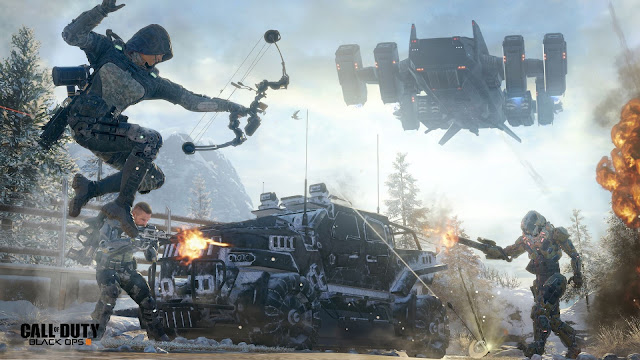The Lesson Call of Duty's "Advanced Movement" Can Teach Us
I've been thinking lately about Call of Duty's "advanced movement" phase. When from 2014 to 2016 Call of Duty gave everyone jet thrusters in an attempt at advanced mobility. This era is generally regarded fairly poorly by the COD fandom. Most of the issues behind it have been talked into the ground, about how weapon balance got thrown off, how map design got ruined, and how futuristic movement doesn't belong in a series like COD. But I think this era is vital, as it can teach people about why momentum in a game is so important.
Now, for those not in the know; Momentum is what allows the player to carry movement energy from one action to the next. If I'm running and jumping my movement doesn't dead stop when I hit the ground, I'll keep going a little more than expected. The best games with speed usually allow the player to carry their momentum from action to action using the resources the game has given them. For example, in Classic Sonic the Hedgehog games if I use Sonic's ball form correctly on downward slopes, I can gain a crazy amount of speed and zoom through the level.
By contrast, Sonic the Hedgehog 4 has none of that momentum, there is no feeling like Sonic's momentum is transferring from action to action. Granted, Sonic 4's physics are so wack that Sonic can unironically stand on walls without dropping like he should so it's not a shock that the momentum doesn't exist. Either way the end result was that Sonic 4 didn't feel quite right compared to the other game in the series, and as such the game was not very memorable and largely became a joke amongst its fanbase.
By contrast, Sonic the Hedgehog 4 has none of that momentum, there is no feeling like Sonic's momentum is transferring from action to action. Granted, Sonic 4's physics are so wack that Sonic can unironically stand on walls without dropping like he should so it's not a shock that the momentum doesn't exist. Either way the end result was that Sonic 4 didn't feel quite right compared to the other game in the series, and as such the game was not very memorable and largely became a joke amongst its fanbase.
But I was talking Call of Duty so let's tie it back into FPS' with a recent example, Halo Infinite. In that game when I'm running and use the grapple ability on a floor, I can use the momentum stored from my run, transfer it into a slide when I touch the ground and basically zoom across the map. Titanfall 2 and Apex Legends are also excellent at this, usually being able to use my sprint along with the terrain to slide and jump in order to gain speed in a way that normal running alone cannot accomplish.
By contrast Call of Duty's "advanced movement" games do not have that sense of momentum even with jump thrusters and wall running. The movement feels slow and sluggish, your momentum does not transfer to the next movement with the small exception of sliding from a fall but even that feels like a band-aid. Simply put, the "advanced movement" of COD wasn't really as advanced in the way Titanfall or Halo are, and it isn't as fun as a result. Mind you that's on top of all the other issues with COD's advanced movement era that I mentioned.
For COD's normal gameplay before and after this era, momentum genuinely doesn't matter. If you're rushing at your foes, you're either an insane man with an SMG/Knife or you're doing it wrong. With Advanced Movement however the point is to encourage players to go faster. But if the inherent game physics don't maximize your speed it can result in inconsistent game feel and that's honestly what killed COD's Advanced movement era, the game's engine and physics didn't agree with the concept at hand, so it felt like players were wearing an ill-fitting suit.
By contrast Call of Duty's "advanced movement" games do not have that sense of momentum even with jump thrusters and wall running. The movement feels slow and sluggish, your momentum does not transfer to the next movement with the small exception of sliding from a fall but even that feels like a band-aid. Simply put, the "advanced movement" of COD wasn't really as advanced in the way Titanfall or Halo are, and it isn't as fun as a result. Mind you that's on top of all the other issues with COD's advanced movement era that I mentioned.
For COD's normal gameplay before and after this era, momentum genuinely doesn't matter. If you're rushing at your foes, you're either an insane man with an SMG/Knife or you're doing it wrong. With Advanced Movement however the point is to encourage players to go faster. But if the inherent game physics don't maximize your speed it can result in inconsistent game feel and that's honestly what killed COD's Advanced movement era, the game's engine and physics didn't agree with the concept at hand, so it felt like players were wearing an ill-fitting suit.
Partly as a result of this, many COD players became frustrated by the advanced movement era and now that COD has gone back to "Boots on the Ground" since 2017, the advanced movement has become an odd footnote in the series' life span. But I think this era of COD is a vital footnote for game devs, to teach them why a proper momentum-based game system matters. So at least in one way, this era of COD wasn't a total failure.
(PS: Fuck Bobby Kotick, hated that guy since 2009).
(PS: Fuck Bobby Kotick, hated that guy since 2009).






Comments
Post a Comment